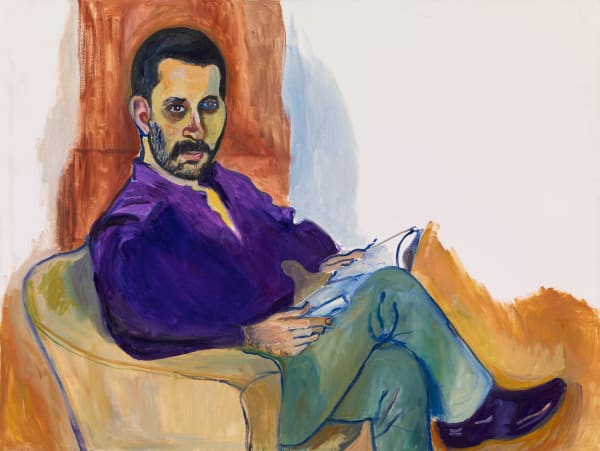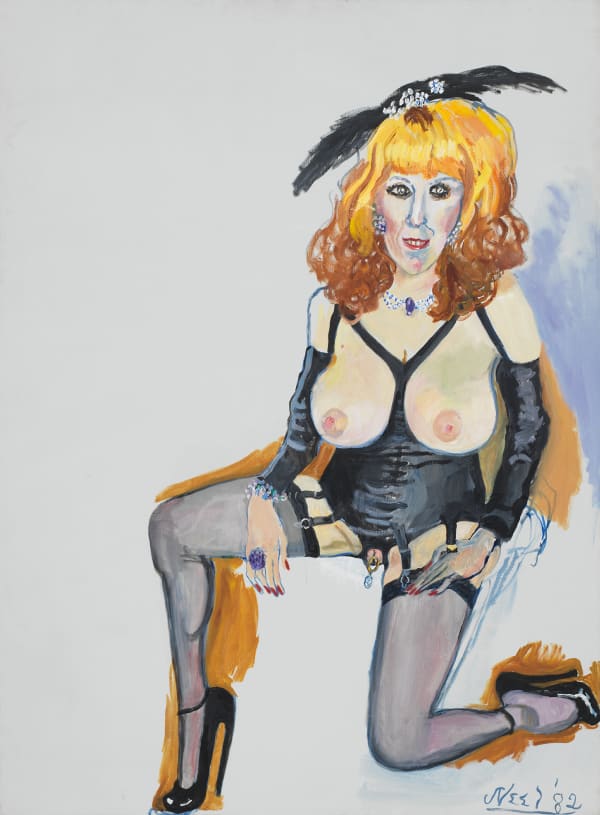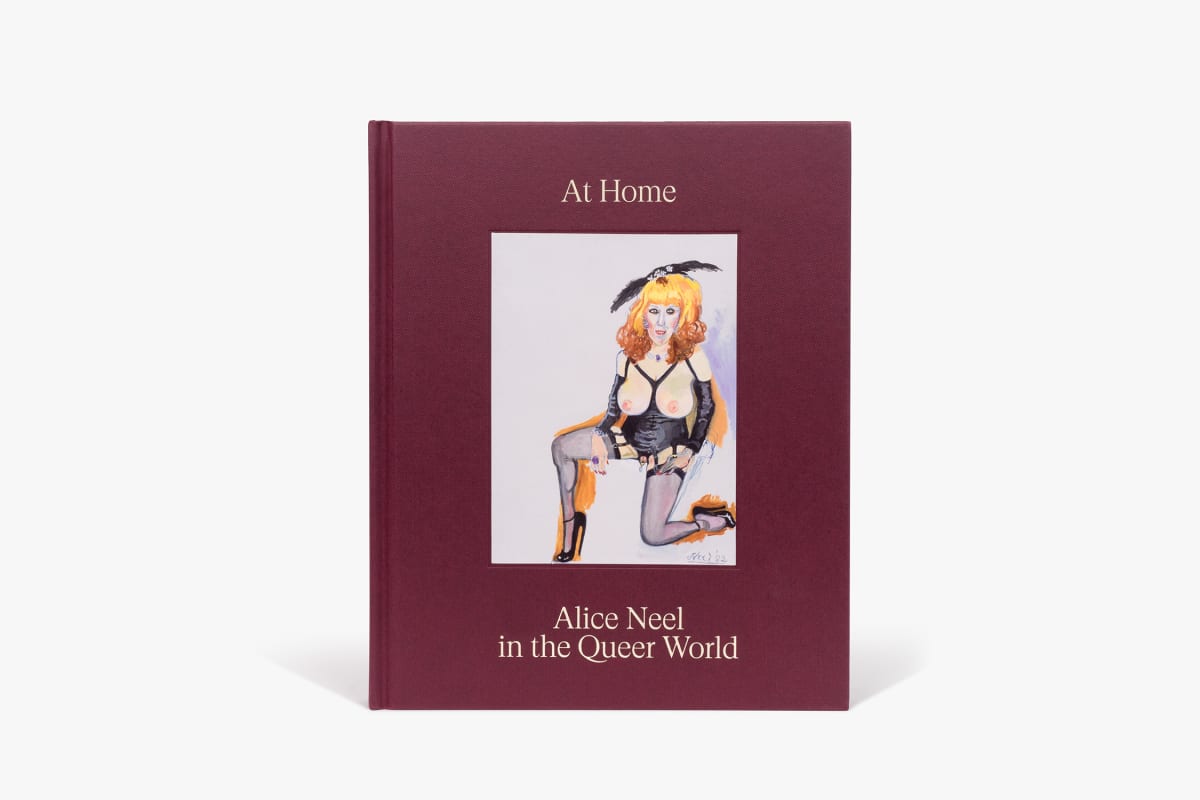At Home: Alice Neel in the Queer World
Victoria Miro is delighted to present At Home: Alice Neel in the Queer World, curated by Hilton Als. The gallery’s ninth solo exhibition of works by the celebrated American painter further extends an ongoing exploration of aspects of Neel’s work and its continuing relevance today.
One of the foremost painters of the twentieth century, and among its most radical, Alice Neel (1900–1984) is known for her daring honesty in her pursuit of what she termed ‘the truth’ – of the individual and the broader society in which individual lives were lived. At Home: Alice Neel in the Queer World highlights the artist’s career-long commitment to depicting the human condition and her practice of painting people from many walks of life.
This exhibition focuses on her paintings of people from queer communities and those who were a part of their circle. The works on view include paintings of writers, performers and artists, as well as friends and neighbours – together forming a collective portrait that both embodies and complicates an understanding of the queer world of Neel’s moment and the artist’s place within it. As Als notes, this exhibition includes ‘not just portraits of gay people but those of theorists, activists, and so on who would qualify as queer by virtue of their different take in their given field and thus the world. So doing, they reflect Alice’s own interest in and commitment to difference.’
Highlights include paintings of figures such as Frank O’Hara (one of two paintings of the poet and curator completed by Neel in 1960); the provocative Beat poet Allen Ginsberg, whom she painted from memory in 1966 after seeing him at a performance; performance artist and sexual icon Annie Sprinkle (1982); and Andy Warhol in a drawing (c.1970) inscribed to performers Jackie Curtis and Ritta Redd – further reflecting Neel’s interest in various creative and avant-garde communities. Also on view will be related archival material that illuminates the lives and accomplishments of the individuals depicted by Neel and their surrounding historical and cultural contexts. These subjects, united here through a connecting thread of difference, demonstrate the breadth of Neel’s work and the unfettered scope of her humanist vision.
As Als writes in his essay for the accompanying publication:
‘When she died in 1984, Neel had a great number of masterpieces to her credit, a galaxy of masterpieces, I would say, that bear witness to the terror we usually turn away from, having no language for it, namely alienation, disconnect, love. […]
As an artist, Neel gave so many people their name – the right to their name. So doing, she told us that no person is fixed; we have as many names as the lies we tell, the truths we live. In my dreams of a glittering gay world… it never occurred to me that that universe wasn’t about inclusion; my imagination already included me. But Neel’s paintings offered something definitive and real, something larger than “identity.” She seemed to be saying in canvas after canvas that there was no word or image that could equal those fleeting moments of joy – of connectedness – that bound her not only to her subjects, but to painting itself, that solitary act that she performed in front of other people.’
The first iteration of this exhibition, also curated by Als, took place at David Zwirner, Los Angeles, 7 September–2 November 2024.
The exhibition is accompanied by an expansive catalogue, published by David Zwirner Books. Edited and with a text by Als, the volume includes newly commissioned scholarship on the artist by Alex Fialho, Evan Garza, and Wayne Koestenbaum.
Alice Neel was born near Philadelphia, Pennsylvania in 1900 and died in 1984 in New York. Recent institutional exhibitions include Alice Neel: Feels Like Home, Orange County Museum of Art, California, USA (2023–2024); the major retrospective, Alice Neel: Un regard engagé, highlighting the political and social commitment of the painter, at the Centre Pompidou, Paris, France (2022–2023), which travelled to the Barbican Centre in London, UK (Alice Neel: Hot Off The Griddle, 2023) and to MUNCH, Oslo, Norway (Alice Neel: Every Person is a New Universe, 2023); and the acclaimed 2021–2022 touring survey Alice Neel: People Come First, organised by The Metropolitan Museum of Art, New York, USA, in association with the Guggenheim Museum Bilbao, Spain, and The Fine Arts Museums of San Francisco, USA.
Previous solo institutional exhibitions include Alice Neel: Painter of Modern Life at Ateneum Art Museum, Helsinki, Finland (2016) travelling to Gemeentemuseum, The Hague, Netherlands (2016–2017), Fondation Vincent van Gogh, Arles, France (2017), Deichtorhallen, Hamburg, Germany (2017–2018); Alice Neel: The Subject and Me, Talbot Rice Gallery, The University of Edinburgh, UK (2016); Alice Neel: Intimate Relations, Nordiska Akvarellmuseet, Skarhamn, Sweden (2013); Alice Neel: Painted Truths, a retrospective that toured to the Museum of Fine Arts Houston, USA (2010), the Whitechapel Art Gallery, London, UK (2010) and the Moderna Museet, Malmö, Sweden (2010–11); Collector of Souls at the Moderna Museet, Stockholm, Sweden (2008) and Alice Neel, organised by the Philadelphia Museum of Art, USA and travelling to the Whitney Museum of American Art, New York, USA (2000).
Neel’s work is in the collections of major museums including the Metropolitan Museum of Art, New York, USA; Tate, London, UK; the Art Institute of Chicago, USA; the Brooklyn Museum of Art, New York, USA; the Denver Art Museum, USA; the Milwaukee Art Museum, USA; the Moderna Museet, Stockholm, Sweden; the Museum of Contemporary Art, Los Angeles, USA; Los Angeles County Museum of Art, USA; the Museum of Fine Arts, Boston, USA; the Museum of Fine Arts, Houston, USA; the Museum of Modern Art, New York, USA; the Philadelphia Museum of Art, USA and Whitney Museum of American Art, New York, USA.
Hilton Als is an award-winning journalist, critic and curator. He has been a staff writer at The New Yorker since 1994. Prior to The New Yorker, Als was a staff writer for The Village Voice and an editor-at-large at Vibe. He has received numerous awards for his work, including the Pulitzer Prize for Criticism (2017), Yale’s Windham-Campbell Literature Prize (2016), the George Jean Nathan Award for Dramatic Criticism (2002–03), and a Guggenheim Fellowship (2000). His first book, The Women, was published in 1996. His next book, White Girls, was a finalist for the National Book Critics Circle Award and the winner of the Lambda Literary Award in 2014. His most recent book, My Pinup, was published in November 2022. In 2017, he curated the critically lauded exhibition Alice Neel, Uptown, which travelled from David Zwirner, New York, USA to Victoria Miro, London, UK and Venice, Italy. In 2019, Als presented God Made My Face: A Collective Portrait of James Baldwin at David Zwirner, New York, USA, followed by Frank Moore at, David Zwirner, New York, USA (2021) and Toni Morrison’s Black Book, at David Zwirner, New York, USA (2022). He curated a series of three successive exhibitions for the Yale Center for British Art, New Haven, Connecticut, USA, of the work of Celia Paul (2018), Lynette Yiadom-Boakye (2019), and Njideka Akunyili Crosby (2022). In 2022, he curated Joan Didion: What She Means at the Hammer Museum, Los Angeles, USA, which travelled to the Pérez Art Museum Miami, USA in 2023–2024. He is currently a teaching professor at the University of California, Berkeley, and has also taught at Columbia University’s School of the Arts, Princeton University, Wesleyan University, and the Yale School of Drama.
-

On view in Turin – Alice Neel: I Am the Century at Pinacoteca Agnelli
October 30 2025The first retrospective in Italy dedicated to Alice Neel, the exhibition (31 October 2025–6 April 2026) will highlight Neel’s pioneering gaze and interest in humanity in all its forms.Read More -

Hilton Als speaks to Dazed about At Home: Alice Neel in the Queer World
February 12 2025'Alice Neel gave us the opportunity to touch and understand each other, even if for a little bit.'Read More -

Curator Hilton Als talks to Wallpaper* about At Home: Alice Neel in the Queer World
January 31 2025‘Ultimately what I loved about these “queer” pictures is what I love throughout her art: empathy devoid of sentimentality.’Read More -

At Home: Alice Neel in the Queer World reviewed in The Times
January 30 2025★★★★ 'And this is Neel's skill, quite apart from her ingenious use of colour (her skins are superb, flaws and all) and keen observation. She draws out the person, gives them life on the canvas.'Read More -

Art Review selects At Home: Alice Neel in the Queer World as one of its exhibitions to see in January
January 6 2025’For Alice Neel, her practice of painting people from many walks of life, from neighbours to writers, performers, artists, politicians and activists – friends and strangers – led her to share this intimate space with a dizzyingly diverse range of subjects.’ – Louise Benson. The exhibition opens in London on 30 January.Read More

